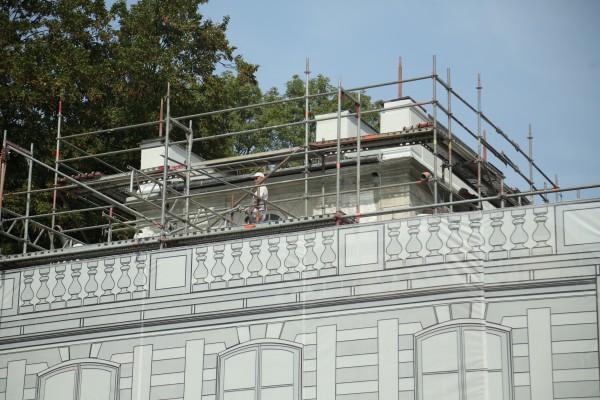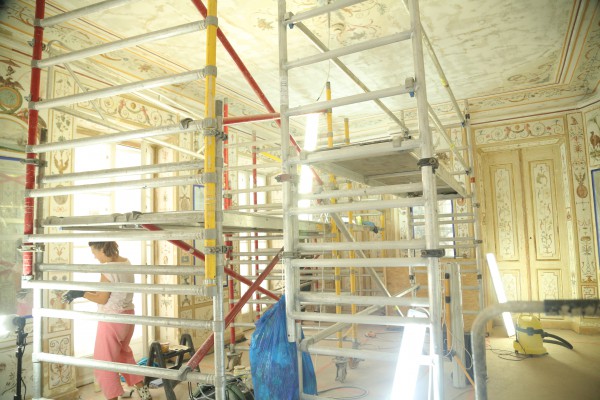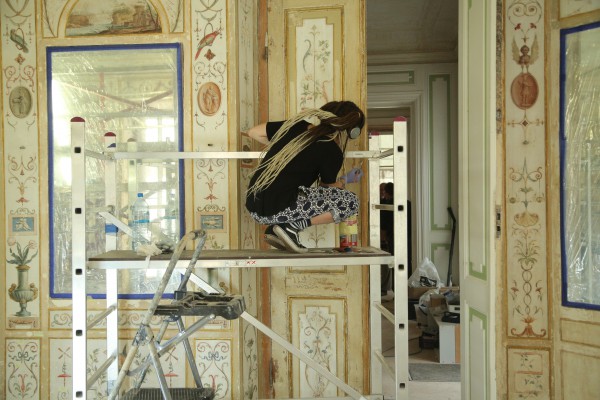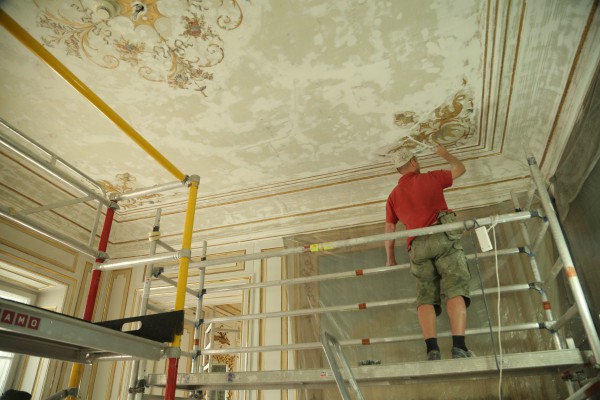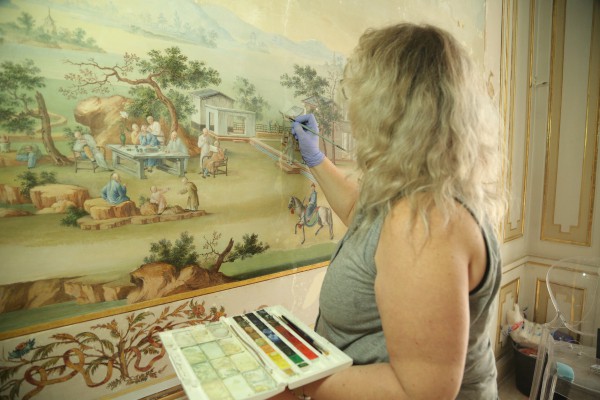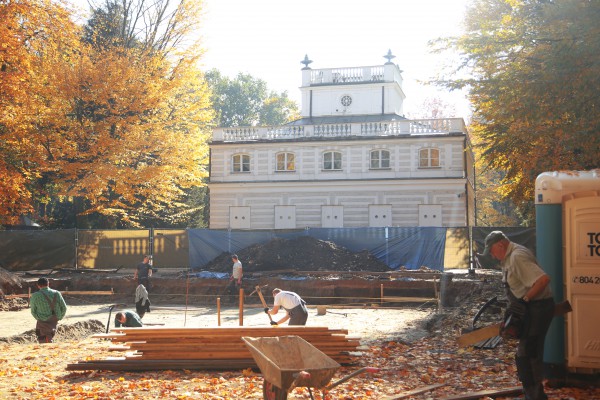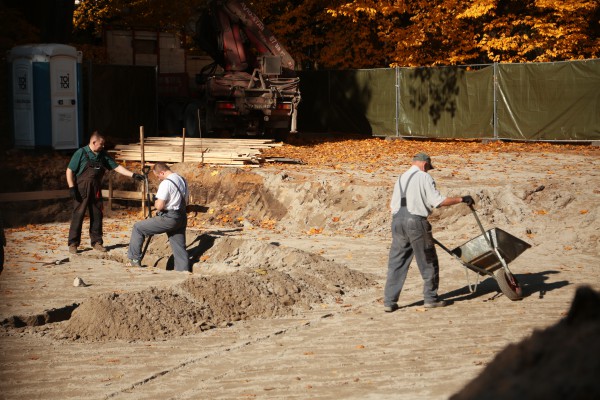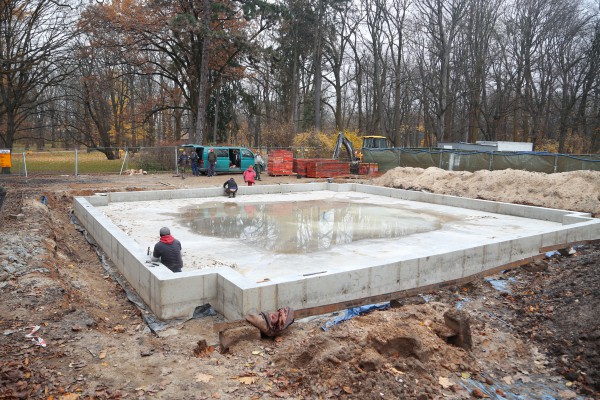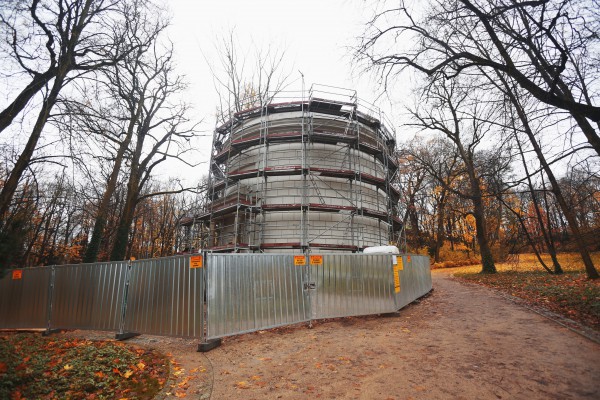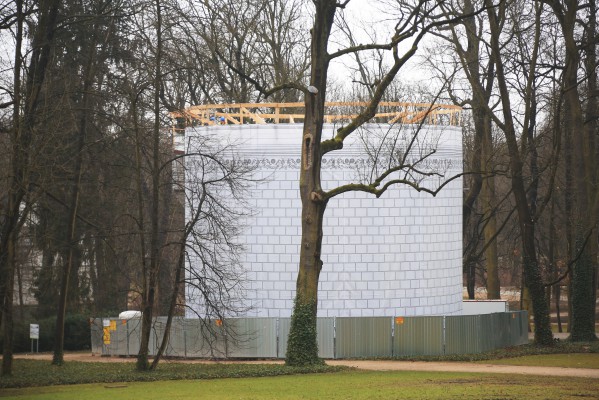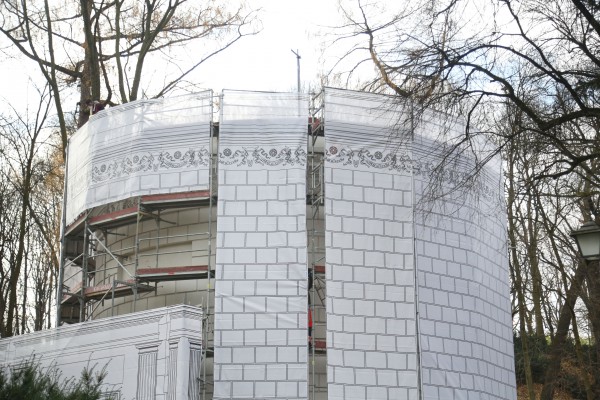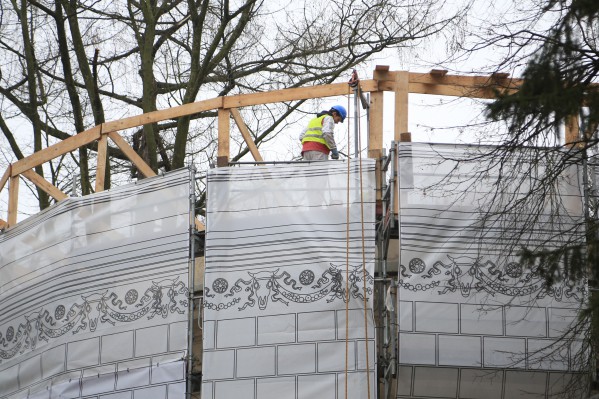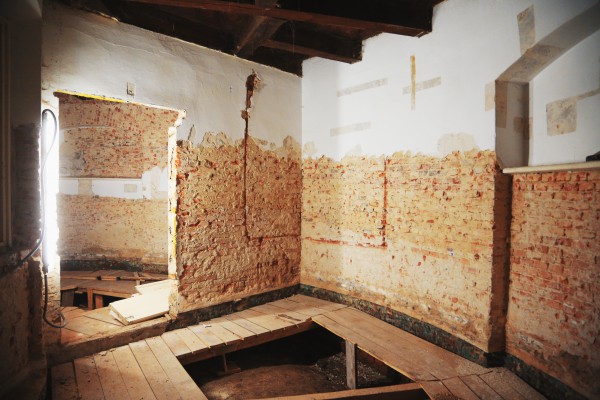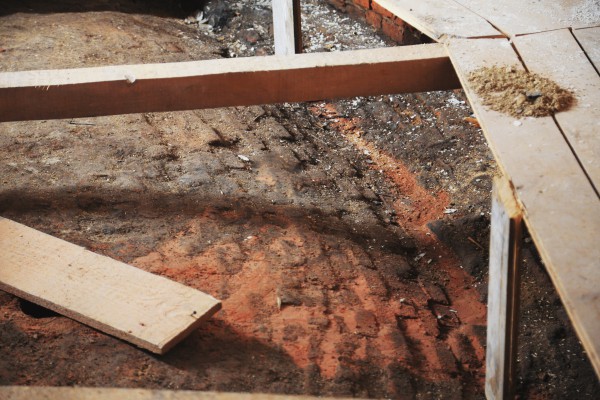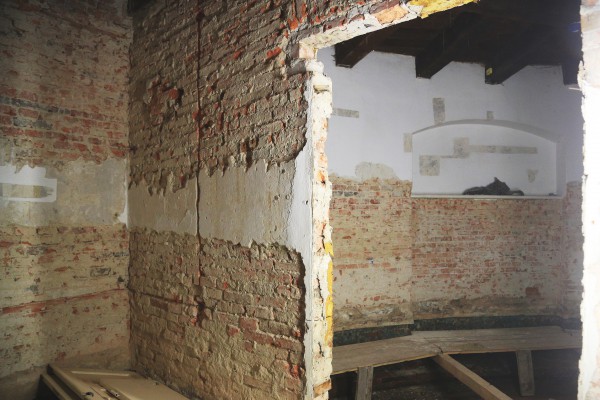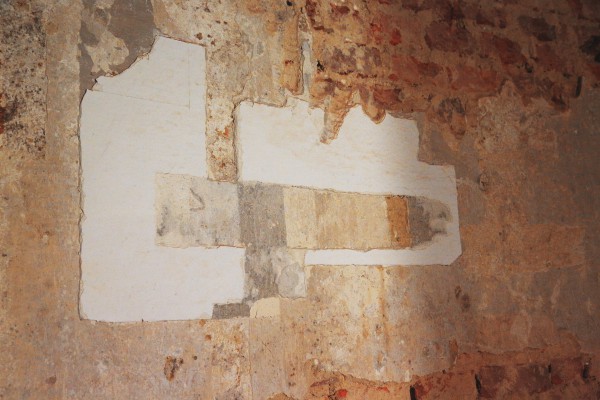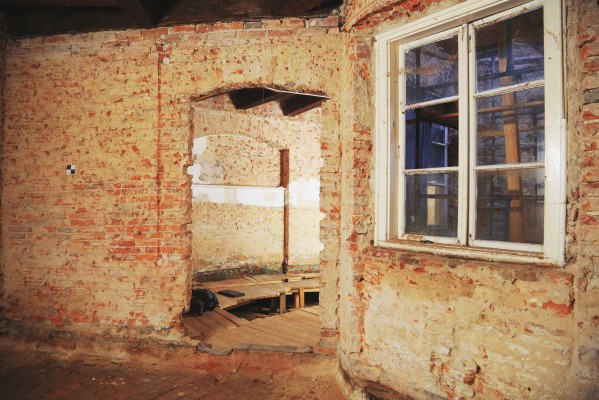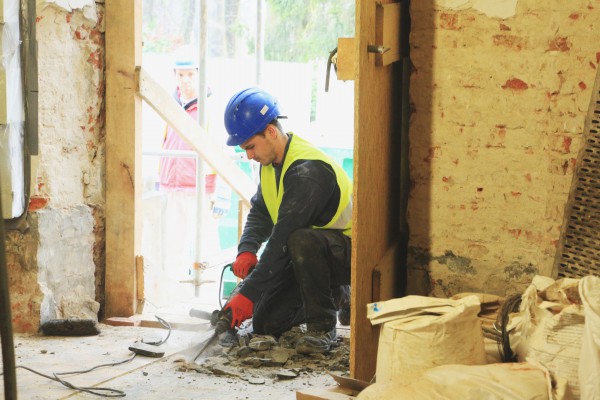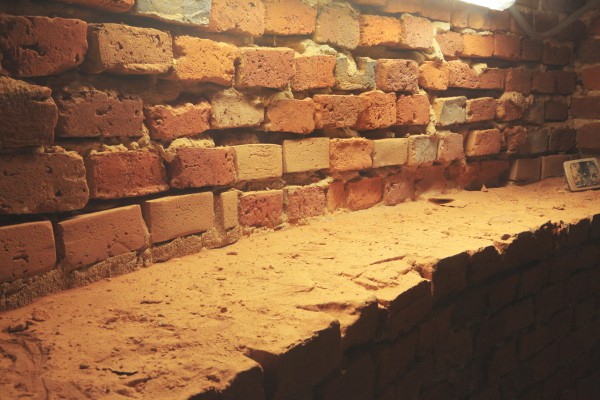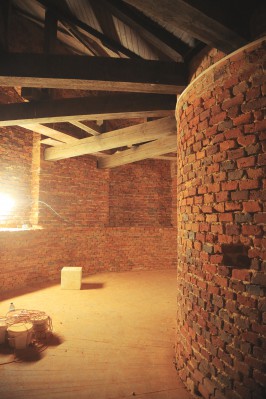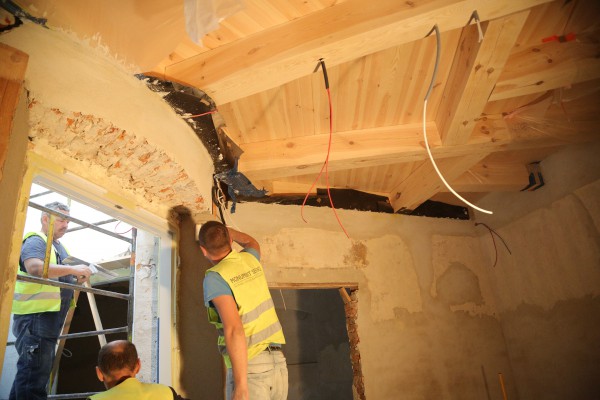
Conservation and Renovation of the White Pavilion and the Water Tower Together with the Historic Garden

The White Pavilion and the Water Tower have been restored to their former splendour. Featuring new displays and an educational and cultural programme, they will open to visitors in spring. The historic garden surrounding both monuments and the relics of the Neogothic Orangery have also been renovated.
In the Royal Łazienki, the years 2017-2019 saw the implementation of the project "Sources of Transformations. Protection and Sharing of the Historic Heritage of the Royal Łazienki. Conservation and Renovation of the White Pavilion and the Water Tower Together with the Historic Garden of the Royal Łazienki Museum in Warsaw" as a next step of the program of regeneration of the whole palace and park complex.
The cost of the project amounted to 17,489,733.91 zlotys, including 10,655,784.63 zlotys transferred by the Ministry of Culture from the European Regional Development Fund under the Operational Program Infrastructure and Environment 2014-2020, while the amount of 2,663,946.17 zlotys was earmarked by the Ministry of Culture and National Heritage.
Extensive conservation and renovation works were performed on two monuments located on the western edge of the Royal Promenade – the White Pavilion and the Water Tower. Also the historic garden surrounding the monuments and the relics of the Neogothic Orangery were regenerated. The efforts were aimed at securing the historic substance of the pavilions and preparing them for museum displays to be presented there. As a result of the project, space for new educational and cultural activities was created.
Villa with original polychromes
The White Pavilion is one of the most unique Polish monuments of the 18th-century residential architecture: preserved almost in its entirety together with the interior decoration and a part of the furnishings. This compact pavilion, built on a square plan and surrounded by a canal, was developed as a summer villa for King Stanisław August. Eventually, for his summer residence, the monarch chose the expanded baths, and the White Pavilion served the guests from the closest circle of the ruler.
In the last two years, the villa underwent comprehensive conservation and renovation works. The primary objective was to preserve the original substance, enhance its unique artistic value and restore the historic design of the interiors. Based on research work and archival queries, a team of conservators conducted comprehensive conservation and restoration of the painting decorations of Jan Bogumił Plersch and Jan Ścisły, adorning the interior of the White Pavilion. At the same time, under present-day layers of paint, original hidden elements were uncovered of the polychromes and fragments of paintings in the bedroom which had been used by the family of King Stanisław August. The roof, stairs and ceiling of the building were repaired. Renovation works encompassed the interiors, polychromes, ceiling plasters, floors, fireplaces and wooden decorations. Conservation measures were applied to the facade and ornaments. The external carpentry, the windows and the colours of the building regained their original appearance. The exhibition display of the White House, which the guests of the Royal Łazienki can see already in spring 2020, will include among other things a collection of royal prints of the "Metamorphosis" series and the original furnishings from the time of the last ruler of Poland.
Water Tower opened after many years
Thanks to the project "Sources of Transformations", visitors will have the opportunity to see, for the first time in many years, the Water Tower which in the times of Stanisław August was a brick rotunda converted in 19th century according to a design modelled to the antique tomb of Cecilia Metella by the Roman Via Appia. The building, also called the Reservoir and once used as a water tank supplying water to adjacent buildings and fountains, today underwent thorough conservation and renovation works. In the building, which bears testimony to former technological solutions, historic interiors were restored along with relics of the original functionalities. These include among other things the reconstructed polychromes, heating equipment and a wooden gutter uncovered under the floor of the vestibule and once used to drain water from the courtyard.
The extraordinary history of the Water Tower will be told by an exhibition about the old water management system of the Royal Łazienki. Visitors will be able to discover the symbolism of water used by Stanislaw Herakliusz Lubomirski and Stanislaw August and the importance of aquatic performances in the process of building up prestige by the last king of Poland.
The garden in its historical form
The project "Sources of Transformations" covered also the regeneration of the relics of the Neogothic Orangery. These are the remains of an impressive building erected in the vicinity of the White Pavilion, by the route leading from the Belvedere to the Palace on the Isle. The walls resting on the ground were in bad condition and required urgent conservation measures. Archaeological research carried out on that occasion allowed to confirm the former function of the building, and specify in approximation its original size, ornaments and colours.
The works in the historic garden surrounding the White Pavilion and the Water Tower were designed to restore its historical form, known from documents, studies and iconographies. They comprised among other things the adjustment of the height system, upgrade of the surface and rehabilitation of greenery. Historic elements of small garden architecture were put in place (benches, pots); they were designed according to archival sources, mainly watercolours of Zygmunt Vogel dating from 1786.
A more accessible museum
The Royal Łazienki Museum’s priority is to adapt the cultural and educational offer to the needs of the disabled. As part of the project "Sources of Transformations", the White Pavilion and the Water Tower were equipped with facilities for visitors with special needs. In the interiors of the 18th-century villa, visitors can now use audio descriptions and audio guides, and typhlographics of paintings, sculptures, furniture, wallpapers, vases, clocks, prints from the Royal Collection of Prints of Stanisław August and views of the facade of the White Pavilion. The display in the Water Tower offers typhlographics of exhibits, of the view of the facade and typhlomaps of the ground floor and the first floor. Moreover, three-dimensional tactile mock-ups of the Water Tower, the White Pavilion and the garden with the water system of Łazienki became part of the exhibition. For the hearing-impaired, induction loops and videos translated into the Polish Sign Language were prepared.
The Museum also strives to ensure access to the interior of the buildings to persons with mobility impairments. For that reason, the rooms were specially adapted, among other things through the removal of thresholds and level differences and adjustment of the furniture arrangement, as well as purchase of a lift for wheelchairs for children and adults and poles with a chair of a tripod type.
Regeneration of the Royal Łazienki
The conservation and renovation works, which were carried out in the White Pavilion and the Water Tower, form another stage of regeneration of the Royal Łazienki. The process began in 2010. Since then, the major buildings of the royal residence were restored to their former splendour: The Palace on the Isle, the Old Orangery and the Myślewicki Palace. Conservation works covered also valuable painting collections, sculptures and graphics. A part of the historic garden of the Museum was redeveloped as well. In total, the regeneration programme cost over 130 million zlotys and was financed among other from European funds, the Norway Grants, funds from the Ministry of Culture and National Heritage and National Fund for Environmental Protection and Water Management.
In order to ensure that projects co-financed by the European Union are implemented in an ethical, public and transparent manner, we wish to inform you that reports of possible irregularities and fraud may be communicated via e-mail at naduzycia.POIS@mfipr.gov.pl or through the electronic reporting system; an appropriate form is available at http://www.pois.gov.pl/strony/zglaszanie-nieprawidlowosci/.

CHRONOLOGY OF WORKS TO BE CARRIED OUT AT THE WATER TOWER AND THE WHITE PAVILION
October 2019 – "Sources of Transformations" project on the final straight
The works on the Neo - gothic Orangery have finished, i.e. the remains of an impressive building, which were erected close to the White Pavilion, at the path from Belvedere to the Palace on the Island. Thanks to conservation and ground works, conservation status and building’s aesthetics were significantly improved. Also, a wide archeological research program was possible, which allowed to confirm the object of the building, approximate its original size, decorative detail and color scheme. There have been reconstructed and exposed, among others: the original level of the entrance to the building from the north, detail of the source with the head of Faun, historic pavement from the south. The works in other objects are also in the finish line. An exhibition on the theme of water and its role in the history of the Łazienki is installed in the Water Tower. On the other hand, exhibition furniture is being created for the permanent exhibition in the White Pavilion. There are also facilities dedicated to disabled people to both buildings on an ongoing basis, including audio descriptions, typhlographics, films translated into Polish Sign Language. The White Pavilion and the Water Tower will be opened for the visitors in the next spring.
September 2019 – The Łazienki is more available
The Royal Łazienki Museum has chosen a contractor of the typhlographics to the need for the exposition in the White Pavilion and in the Water Tower. As a part of the project, typhlographics will be prepared including: paintings, sculptures, furniture, wallpapers, vases, clocks, graphics from the Royal Graphic Collection of Stanisław August and the views of the façades of the White Pavilion. On the other hand, the Water Tower exposition will be enriched with typhlographics exhibits, contents, façade view and typhlomap of the ground floor and the first floor. Tylphographics and tylphomaps are just one of the actions that are implemented within the project "Sources of transformations". Their goal is to open the Royal Łazienki for all visitors, with particular attention to people with individual needs. Having them in mind there were prepared or are being prepared also: photo’s audio description, movies in Polish Sign Language, simple text, 3D exhibition models, induction loops were installed. The Museum is taking action to make the interiors of the buildings more available for people with mobility impairments. Because of that, the rooms are adapted by elimination of the thresholds, the differences between the levels or buying wheelchairs for kids and adults.
August 2019 – the e-Library is completed
The website "Sources of Transformations - Digital Library of the Royal Łazienki Museum in Warsaw", where 50 publications from the Enlightenment in electronic form is available, is completed. The main goal of the project is to promote literature canon form the 18th century - the time when the White Pavilion was created. Readers will find in the Library’s resources writings of the best European creators, among others: Johann Wolfgang von Goethe, Friedrich Schiller, Carl Goldoni, Pierre de Marivaux, Adam Naruszewicz, Ignacy Krasicki, Stanisław Trembecki. Publications will be able to use by reading the website (online) as well as by downloading publication file to the device in popular e-book format. The additional benefits which are offered by the Library for its readers are, among others: an opportunity to e-Library’s resources full-text search, responsiveness - matching the website and publication content to the screen size of the device. With a view to partially sighted people functions of enlarging and reducing text and changing the view to black and white contrast were also implemented. E-Library was created within the framework of the project "Sources of Transformations. Protection and Sharing of the Historic Heritage of the Royal Łazienki. Conservation and Renovation of the White Pavilion and the Water Tower Together with the Historic Garden of the Royal Łazienki Museum in Warsaw".
July 2019 – conservational renovation of The Gothic Orangery’s relic
The Royal Łazienki Museum has sign a contract for the conservational renovation of The Gothic Orangery’s relics. The Gothic Orangery’s relics are situated in a historic Palace – Garden Complex of the Royal Łazienki, in the western part of the park, in the area of the White House. The garden’s revitalization, in the surroundings of the White House, through the correction of the system, the modernization of a pavement and the revitalization of the greenery along with drainage installation and irrigating installation as well as a renovation and conservation of a small garden architecture – The Gothic Orangery’s relics and the fountain at the Royal Promenade – will let to return a historic form and a value of this part of the Łazienki Garden. The renovation and conservational work of The Orangery’s relics is the last construction task within the framework of the project "Sources of Transformations. Protection and Sharing of the Historic Heritage of the Royal Łazienki. Conservation and Renovation of the White Pavilion and the Water Tower Together with the Historic Garden of the Royal Łazienki Museum in Warsaw".
June 2019 – revitalization of the White Pavilion’s surroundings
The work connected with revitalization of the White Pavilion’s surroundings and reconstruction of bowling – green has begun. The project’s goal is to restore a historical form of the garden which is known from documents, researches and iconography. The correction of a system is being planned, including high – altitude system, pavement modernization, and greenery revitalization. The introduction of historical elements of the garden’s small architecture is planned – planter with exotic trees and benches. Projects of those elements are based on archival source, most of all on Zygmunt Vogl’s watercolor paintings from 1786.
May 2019 – new benches and planters in the Royal Łazienki’s gardens
New benches and planters with orange trees have appeared on the premises of the Royal Łazienki. Picturesque elements of a small garden architecture have been placed in front of the Water Tower and Myślewicki Palace, at the Old Orangery and at Zazdrość Roundabout. They have been created according to wood conservator Wojciech Richter’s individual project, which was based on historical patterns from Stanisław August’s era. Archival materials allowed, among other things, to recreate a layout and color of strips on planters. The implementation of the project was possible thanks to funds from European Regional Development Fund as part of the 2014-2020 Operational Programme "Infrastructure and Environment".
April 2019 – revitalization of the territory around the Water Tower and the White Pavilion
The intensive works that aim at revitalization of the territory around the Water Tower and The White Pavilion are happening all over. The Royal Łazienki Museum has put out the tender for the delivery and the installation of guard pavilions which will replace existing ones. The order applies to two pavilion types – a small guard shack and a big guard shack, reception type. The procedure of selecting the contractor of the garden recreation around the White Pavilion is in progress. The task is to create a parking surface as well as a land development which involves an arrangement of a bowling green with vegetation planting and creating an irrigation system. In addition, the subject of the contract is also a delivery of a small architecture to the White Pavilion’s nearest surroundings.
March 2018 – renovation of the external sewer system of the White Pavilion
The work connected with the renovation of the White Pavilion has started. The replacement of the installation, whose technical condition left a lot to be desired, has a fundamental meaning for ensuring the safety of the antique substance. As part of the work the installation of additional inspection wells is planned in the place where a sanitary sewerage is connected with a wet sewerage as well as in places where the direction of a sewage system is changed. The contractor task will be also to connect reinforced concentrate drainage lift’s for disabled shaft station, which was designed in the territory in front of the White Pavilion’s entry. A planned date of the end of the work is May 2019.
February 2019 – contractors of an expositional model for the Water Tower are chosen
The Royal Łazienki Museum has chosen contractors of two models for a new exposition which arises in the Water Tower, which will be available for visitors soon. The first one will present a 3D block of the building on the scale of 1:25. The second one will visualize The Garden of The Royal Łazienki with main buildings and chosen parts of a small architecture including gazebos, monuments, the main bridge and the wall of the Orangery. On the model there will be also visible water reservoirs, hydrological system (fountains, drains), alleys and lawns, main entrances to the garden and to buildings. Models will be prepared in contrastive colours with a view to partially sighted. The block of the building, its interior and details will be possible to read using the touch, using the shape and the texture. Adjusting an offer to people who have limited access to a cultural goods is one of the priorities of the Museum. The elimination of architectural barriers, audio descriptions, tactile graphics and tactile aids, audio-visual materials in Polish Sign Language, specific cultural – educational programs – all of them are only certain activities which are taken in favour of the opening of The Museum collections for people with special needs.
January 2019 – Refurbishment of the White House roof
We are beginning the refurbishment of the White Pavilion roof. Inspections conducted during construction works on the building façade and the attic have confirmed the critical condition of the wooden frame and roofing elements. Once the roof frameworks and the slab were exposed it was found that the material had significantly deteriorated due to dampness, the use of fire protection materials and the presence of feeding grounds of xylophage insects. At the same time, an analysis performed by the Art Conservator Association Expert has shown that the roofing framework was not original and had been rebuilt multiple times. The repair, replacement and reinforcement of these structural elements of the roof will concluded in mid 2019.
December 2018 – Additional funds for the project
Due the necessity of an execution of an additional conservation, Royal Łazienki Museum has raised funds, from The Ministry of Culture and National Heritage, for the work in The White Pavilion. It happened because of the annex to the funding agreement "Sources of Transformations. Protection and Sharing of the Historic Heritage of the Royal Łazienki. Conservation and Renovation of the White Pavilion and the Water Tower Together with the Historic Garden of the Royal Łazienki Museum in Warsaw" which was signed on 3 December 2018. Additional conservation works will include, among other things, parts of pictorial wall decoration of first and second floor, polychromous woodwork and first’s floor paneling. Their extent comes from applications from The Conservatory Commission, which affirmed earlier that the level of the decoration destruction is much bigger than the program based on a recovery test had assumed. Moreover, thanks to increasing the scope of the project, it will be possible to change the outside part of a sewer installation close to The White Pavilion, as well as to reinforce and partially replace construction elements, sheathing and covering of the building’s roof. The total value of the project after the amendment comes to 16 583 708,07 zlotych.
November 2018 – Finalization of works in the Water Tower
The conservation and renovation of the Water Tower is over. Currently, a permanent exhibition is being prepared in the interiors. The exhibition is about the history of the building which is shown in the background of the Łazienki’s drains as well as it’s historical function. Visitors will be able to see, among others, how the wooden gutter, which took water from the yard of the building, looked like. The Water Tower will be open for visitors in spring, 2019.
October, 2018 – Tender allotment for an archeological research around the Water Tower
The Royal Łazienki Museum has chosen the contractor of an archeological research connected with the Water Tower and its surroundings, also taking into account a power supply and water draining systems. The main aim of the research is to increase awareness of hydrological system in The Royal Łazienki and about the way of supplying water to the Water Tower. The works will be carry out as a part of the project: "Sources of Transformations. Protection and Sharing of the Historic Heritage of the Royal Łazienki".
September 2018 – Works in the Water Tower
Main works in the Water Tower, which are coming to the end, have already allowed guests of Łazienki to see the final effect. A renewed elevation is the most standing out part because outside works have finished first. Inside changes are still ongoing, they are preparing the object for visits of guests. For this purpose, there will be exhibited relicts of heating devices (furnaces) in the hall, as well as other objects which will show a utilitarian function of the building.
August, 2018 – Archeological research on the grounds of the old Neo – gothic Orangery
The Royal Łazienki Museum has received a permission for carrying out an archeological research which will take part in the old Neo – gothic Orangery which is situated in the White House’s surroundings. The aim of the research is to examine preserved archeological relicts of the Orangery. Their extent was initially determined as a result of a geophysical research. The research will be pursue as a part of the project: "SOURCES OF TRANSFORMATIONS. Protection and Sharing of the Historic Heritage of the Royal Łazienki". Works are being currently centered around removing sand and debris from the basement and exposing a corps of the central gothic Orangery from the east side. Except for a part of the decoration, archeologists have found small parts of a painted parget, as well as a part of pots and hearths. Those findings lead to assume that the Orangery was decorated inside. The aim of the research will also be a promotion of an innovative research solutions including usage of 3D scanner during pursuing work. As a result, there will be created an active, three – dimensional (photorealistic) project documentation and then – an interactive model of discovered relicts and accompanying infrastructure. Thanks to that solution, there will be available a movie from virtual walk through the facility on the website of the Royal Łazienki . Information about a publication of the movie will be posted on social media channels.
SEE THE VIDEO: THE OLD NEO – GOTHIC ORANGERY
July 2018 – Conservation works and development of the exposition in the White House
Works connected with a conservation of a door and window woodwork are underway, as well as works connected with repairing the roof and the construction of a ceiling on the first floor. The central heating system has been renovated. The group of conservators has been still working in the building. In the same time, in connection with a development of a new exposition system, the specific document was commissioned "The expertise of the White House 18th century furniture and furnishings". The document consists, among other things, an archival query in polish and foreign archives about previous furnishing and the history of the White House.
June 2018 – The finding in the Water Tower
During a renovation in the Water Tower, there was found a wooden gutter which was buckled with carpentry buckles. The gutter was draining a dirty water from the inside part of a yard to the outside part of the building. A wooden construction was laid at a slant which enabled a gravitative water flow. The object was found in a bricky and stony debris, under a floor of the Water Tower which suggest it’s 18th century origin.
In the framework of restoration works, which are planned, wooden samples will be examined on a dendrologic way. It will determine a type of material which was used to build the gutter. After the examination, the gutter will be thoroughly restored and, after the renovation in the Water Tower, it will probably be exposed on an exhibition about water in the Royal Łazienki.
May 2018 – The Water Tower: a postponement of a termination of the work
Date of a termination of the work has been postponed until the autumn 2018 in conjunction with conservatory discoveries, which were found during the works. Meanwhile, the renovation work on a roof has been terminated. The works connected with a conservation of the elevation and a reinforcement of a tank’s vaults, which were discovered inside the building, are underway.
April 2018 – Conservation works in the White Pavilion
Works in The White Pavilion that are being directed by wall paintings restorers are underway. A major specialist’s task is to clean paintings from previous conservations and dirt, as well as to expose original part as precisely as possible. A team of restorers consists of people with different competences and skills. Eventually, through the revitalization of wall paintings, there will be working at least ten painting restorers, two artists who specialize in a sculpture renovation and a technical stuff as a support.
March 2018 – Additional archeological studies in the Water Tower
The works in the Water Tower are making progress. There has appeared an opportunity to get a fuller knowledge about the building and about its functioning due to current analyses and materials which were obtained during structural – conservation works. A recognition of a container’s underground system of the Water Tower has become essential. Because of a historic nature of the building, the recognition is possible thanks to a deployment of noninvasive archeological methods such as magnetic surveys, resistivity surveys and ground – penetrating radar surveys. The program of noninvasive archeological studies has been developed within the framework of "The archeological expertise – a development of an archival query and of a noninvasive archeological program with an estimate for the Water Tower" which was planned and commissioned in the framework of the project.
February 2018 – Preparation of the Water Tower exhibition
During renovation works which take part in the Water Tower, the project of a constant exhibition in the building is being led. A developed sightseeing path gives an opportunity to lead a viewer through issues connected with a water in the Royal Łazienki Museum. In the same time, all the scenography measures will allow to show the most important aspects of the Water House architecture. The work on a script of the exhibition and on a choice of proper iconographic references is being conducted both ways, as well as a project of an exhibition furniture and finishing materials.
January 2018 – Contract for the renovation of the White Pavilion signed
The Royal Łazienki Museum has signed a contract with a company responsible for renovation and conservation works of the White Pavilion. The range of service covers both the interior and their décor, as well as structural and architectural elements. Wall paintings will be renovated, including the famous grotesques of Jan Bogumił Plersch, court painter King Stanisław August, as well as decorative stuccoes, decorated wooden paneling and floors. The project also provides structural reinforcement of the walls and ceilings of the first floor of the pavilion, which will allow to open this part of the building for visitors. The renovation also includes repairing roof truss elements, replacing the roof covering, restoring the façades of their original historical expression, as well as repairing the window and door joinery. Ultimately, the White House will be the place of exhibition, among others, of Royal Gallery of Graphics, in particular a set of prints from Ovid's Metamorphoses, from the 1767-1771 edition.
December 2017 – Renovation of a fountain in front of the White Pavilion completed
In mid-December, the Royal Łazienki Museum has formally recognized as completed the renovation and conservation works of the fountain located on the Royal Promenade. Damaged construction was replaced by a new one, reinforced with concrete. The original stone covers surrounding the fountain pool have been renovated and returned to their original place. Water installation of the fountain has been adapted to the current standards of purity of water, which will circulate in a closed circuit now. The effects of modernization will be fully visible in the spring, when the water jet will be launched (a "jet d'eau" system), and the flower garden surrounding the fountain will be filled with flowers.
November 2017 – Renovations in the Water Tower and the fountain continues
Renovation and conservation works of the Water Tower are underway. Eventually the building will regain its historical appearance. Lots of valuable information about the past of the building are now available as a result of a query of archival documents, which has just ended. The contractor has already begun cleaning the brick walls inside the building, he also removes the secondary floors. Preparations for the renovation of the rafter framing and façade maintenance have also started. There is also progress in the renovation of the fountain in front of the White House. Many works have already been done, although the final effect will be visible in a while.
October 2017 – Renovation of a fountain in front of the White Pavilion
Renovation of the fountain on the Royal Promenade in front of the White Pavilion has begun. The contractor dismantled the damaged construction and proceeded to prepare a new on, reinforced with concrete. Historical stone elements have been cataloged and will soon arrive at the conservation workshop. The results of the renovation will include maintenance of the historic jet d'eau (waterjet) system and restoration of the flowerbeds surrounding the fountain basin.
September 2017 – The Water Tower construction site starts
The Royal Łazienki Museum has made the Water Tower available for the contractor of renovation. As a result the construction site starts. The scope of work covers a comprehensive renovation of the building, including i.a. replacement of all installations, reinforcement of the walls and lintel, insulation, renovation of the walls, replacement of the door and windows joinery and fittings. The original communication system between the rooms will also be restored. The conservation work plan includes renovation of architectural stone details (including plinth, portico and outer stairs), interior and exterior elevation along with decorative elements (frieze and attic), floors, internal stairs, roofs and roof elements.
August 2017 – Signing of agreement with the contractor
The Royal Łazienki Museum entered into an agreement with the contractor who will carry out the renovation and conservation works at the Water Tower. The works will include renovation and adaptation of the above-ground part of the building, which – due to poor conservation condition – was closed to visitors. The completion of the works is scheduled for the end of May 2018. The Water Tower will be made available to visitors in the spring season of next year. The new exhibition area will feature banners and printed copies of archival materials from the 18th century, as well as a cross-section model of the building, including the equipment used for collecting and storing water.
